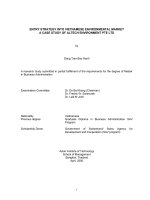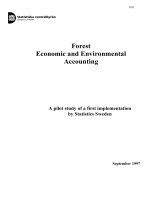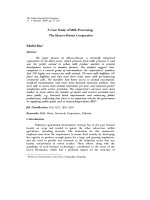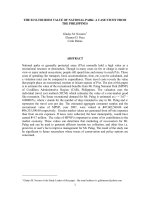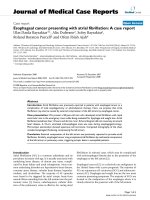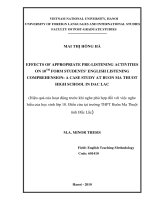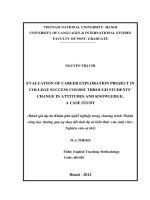eterminants of firm compliance with environmental laws a case study of vietnam
Bạn đang xem bản rút gọn của tài liệu. Xem và tải ngay bản đầy đủ của tài liệu tại đây (1.68 MB, 456 trang )
DETERMINANTS OF FIRM COMPLIANCE WITH
ENVIRONMENTAL LAWS:
A CASE STUDY OF VIETNAM
DAO MAI ANH
NATIONAL UNIVERSITY OF SINGAPORE
2008
DETERMINANTS OF FIRM COMPLIANCE WITH
ENVIRONMENTAL LAWS:
A CASE STUDY OF VIETNAM
BY
DAO MAI ANH
(B.A (Language Translation and Interpretation), Vietnam National
University; M.Sc (Environmental Management), NUS)
A THESIS SUBMITTED
FOR THE DEGREE OF DOCTOR OF PHILOSOPHY
DEPARTMENT OF BUILDING
SCHOOL OF DESIGN AND ENVIRONMENT
NATIONAL UNIVERSITY OF SINGAPORE
2008
- I -
ACKNOWLEDGEMENTS
I would like to express my special gratitude to Prof. George Ofori and Prof. Low Sui Pheng
for their invaluable insight, feedback and guidance. Prof. Ofori’s devotedness as a supervisor
and researcher has greatly inspired my love for research. Step by step, this piece of work of
mine has found its way to final completion under his constant assistance.
My thanks also to the National University of Singapore (NUS) for supporting me financially.
It is in NUS that I find all favorable conditions for carrying out this study.
A great number of senior officials of firms operating in Vietnam have been the core of the
success of this research. My thanks are due to them for providing documents for the case
study, spending time in completing the questionnaire and participating in the interviews.
Finally, I wish to express my appreciation of all forms of assistance to those who gave it.
They make the study possible.
- II -
TABLE OF CONTENTS
ACKNOWLEDGEMENTS i
TABLE OF CONTENTS ii
ABSTRACT vii
LIST OF TABLES ix
LIST OF FIGURES xi
LIST OF ABBREVIATIONS xii
CHAPTER 1 INTRODUCTION 1
1.1 Background of the research 1
1.2 Research problems 2
1.3 Research objectives 4
1.4 Generic theoretical framework 5
1.5 Scope of research 6
1.6 Research methodology 7
1.7 Importance and potential contributions of the research 11
1.8 Thesis outline 12
CHAPTER 2 REVIEW OF THE LITERATURE ON FIRM COMPLIANCE 15
2.1 Purpose of the review and outline of its structure 15
2.2 Theories of firm compliance 16
2.2.1 Rationalist Theories 19
2.2.1.1 Rational models of compliance 19
2.2.1.2 Critics 24
2.2.2 Normative Theories 33
2.2.2.1 Personal morality 34
2.2.2.2 Social influence 36
2.2.2.3 Legitimacy 37
2.2.3 Non compliance 41
2.2.3.1 Firm size 43
2.2.3.2 Information Flow and Organizational Context 47
2.2.4 Conclusion 49
CHAPTER 3 NEW INSTITUTIONAL APPROACH TO STUDYING FIRM
COMPLIANCE BEHAVIOR 51
3.1 Introduction 51
3.2 The need for an overarching framework explaining compliance behavior of firms52
3.3 Institutional approach to organizational studies 57
3.3.1 Introduction 57
3.3.2 New Institutionalism in Economics 61
3.3.3 New Institutionalism in Political Science 64
3.3.4 New Institutionalism in Sociology – New Institutional Approach to
Organization Study 67
3.3.5 Points of Divergence 72
3.3.6 Organizational Field and Corporate Environmentalism 77
3.4 Scott’s three pillars of institutions 83
3.4.1 The Regulative Pillar 85
3.4.2 The Normative Pillar 86
3.4.3 The Cultural-Cognitive Pillar 88
3.5 Organizational behavior and Scott’s three pillars of institutions 89
- III -
3.6
Conclusion 92
CHAPTER 4 CORPORATE ENVIRONMENTALISM AND INSTITUTIONS IN
VIETNAM 93
4.1 Introduction 93
4.2 Overview of business community in Vietnam 94
4.2.1 Vietnam in Brief 94
4.2.2 Market Overview 95
4.2.2.1 Agriculture and Industry 97
4.2.2.2 Foreign Investment 98
4.2.2.3 Legal framework and administrative system governing enterprise sector 100
4.2.2.4 Markets and competition 101
4.3 Environmental issues in Vietnam 103
4.3.1 Deforestation 104
4.3.2 Land Degradation 104
4.3.3 Loss of Biodiversity 105
4.3.4 Water Pollution 106
4.3.5 Air Pollution 108
4.3.6 Urban Pollution 110
4.3.7 Solid Waste 111
4.3.8 Natural Disasters 112
4.4 Environmental management in Vietnam 113
4.4.1 Environmental Stakeholders in Vietnam 114
4.4.1.1 Government agencies 114
4.4.1.2 Non-governmental institutions 117
4.4.2 Environmental Laws and Regulations 121
4.4.3 Water Pollution Control 126
4.4.4 Air Pollution Control 129
4.4.5 Solid Waste Management 132
4.5 Corporate environmentalism and companies operating in Vietnam: organizational
field and institutions 135
4.5.1 Business Environmental Awareness in Vietnam 135
4.5.2 Industrial Pollution 139
4.5.3 Wastewater Treatment Measures by Firms 141
4.5.4 Air Pollution Control Measures by Firms 143
4.5.5 Treatment and Disposal of Hazardous Industrial Waste by Firms 145
4.5.6 Environmental Management Systems 146
4.6 Conclusion 147
CHAPTER 5 EIA – EMS AND THE ROLE OF EMS IN MEETING EIA FOLLOW
UP REQUIREMENTS 149
5.1 Environmental Impact Assessment 151
5.1.1 Overview of EIA 151
5.1.1.1 EIA Process 153
5.1.1.2 EIA effectiveness 155
5.1.1.3 EIA follow-up 157
5.1.1.4 Problems and constraints to follow-up implementation 162
5.1.2 EIA Legislation in Vietnam 164
5.1.3 EIA Procedure 166
5.2 ISO 14001 EMS and its implementation in Vietnam 171
5.2.1 Overview 171
5.2.2 Determinants of ISO 14001 Certification and Implementation 172
5.2.3 Benefits of ISO 14001 EMS Certification and Implementation 175
- IV -
5.2.4
Problems of ISO 14000 Implementation and Certification 182
5.3 Literature review of EIA-EMS linkage 185
5.4 Scoping of elements for the EIA/EMS linkage 189
5.5 Conclusion 195
CHAPTER 6 RESEARCH METHODOLOGY 196
6.1 Research Design 196
6.2 Selection of Methodology: Triangulation method 200
6.2.1 Generation versus Verification 200
6.2.2 Qualitative versus Quantitative 201
6.2.3 Triangulation Method 204
6.3 Research validity and reliability 211
6.3.1 Construct Validity 212
6.3.2 Internal Validity 213
6.3.3 External Validity 214
6.3.4 Reliability 214
6.4 Data collection 215
6.4.1 Secondary Data Collection 216
6.4.2 Interviews 220
6.4.2.1 Choice of interview strategy 220
6.4.2.2 Preparation of interview questions 223
6.4.2.3 Conduct of interviews 224
6.4.3 Survey 225
6.4.3.1 Method of questionnaire distribution 226
6.4.3.2 Designing the questionnaire and importance weights of attributes 227
6.4.3.3 Statistical sampling 228
6.5 Data Analysis 230
6.5.1 Selection of data analysis strategies 230
6.5.2 Open coding 232
6.5.3 Mean importance ratings 233
6.5.4 Statistical tests for difference between means of each attribute 235
6.5.5 Content analysis 238
6.5.6 Factor analysis 238
6.6 Conclusion 243
CHAPTER 7 RESULTS AND DISCUSSION 244
7.1 Case studies results and discussion 244
7.1.1 Reference to EIS When Implementing EMS 246
7.1.2 Project’s Number of Predicted Impacts versus Identified Impacts 246
7.1.3 EIA Proposed Mitigation Measures versus ISO 14001 EMS Implemented
Management Activities 249
7.1.4 Relationship between Impacts Prediction/Identification and Associated
Management Activities 251
7.1.5 Organizational Field and Institutions 252
7.2 Interviews Results and discussion 256
7.2.1 Reasons for Implementation of EIA and EMS Requirements 257
7.2.2 Reasons for Poor Implementation of EIA Follow up Requirements and ISO
14001 EMS 263
7.2.3 The Role of ISO 14001 EMS in Implementing EIA Follow up Requirements
270
7.2.3.1 General format of EMS 270
7.2.3.2 EIA follow up measures and EMS environmental management activities .271
7.2.3.3 ISO 14001 environmental management activities 275
- V -
7.2.3.4
Reference to EIS when implementing ISO 14001 EMS 277
7.2.3.5 Difficulties in making reference to EIA report 278
7.2.3.6 Elements of EIA report that are useful for certification and implementation
of EMS 280
7.2.3.7 Number of impacts predicted in EIA versus impacts identified by ISO 14001
EMS 281
7.2.3.8 Reasons for EIA predicted impacts not to occur in practice 283
7.2.3.9 Implementation of EIA’s proposed management activities under EMS 285
7.2.4 Summary 287
7.3 The firm survey results and discussion 290
7.3.1 Respondents’ Profile 290
7.3.1.1 Response rate 290
7.3.1.2 Business structure, operation, size and location of respondent firms 291
7.3.1.3 Environmental management measures being applied by companies 292
7.3.1.4 EIA Implementation and ISO 14001 EMS Certification and Implementation
294
7.3.2 Reasons for Compliance with Environmental Laws and Regulations 294
7.3.2.1 Attributes rating, t test of the means and factor analysis 294
7.3.2.2 Effects of business structure, size, and types of operation on the importance
ratings of attributes 307
7.3.3 Reasons for Noncompliance with Environmental Laws and Regulations 323
7.3.3.1 Attributes rating, t test of the means and factor analysis 323
7.3.3.2 Additional attributes and other comments 332
7.3.3.3 Effects of size, ISO 14001 certification, business structure and fields of
operation on firms’ noncompliance behavior 335
7.3.4 The Role of ISO 14001 EMS in Implementing EIA Follow up Requirements
349
7.3.4.1 Reference to EIA when implementing ISO 14001 EMS 350
7.3.4.2 ISO 14001 EMS’ coverage of EIA predicted impacts and mitigation measures
351
7.3.4.3 Reasons for more impacts identified than predicted 352
7.3.4.4 Reasons for predicted impacts not to occur in practice 353
7.3.4.5 Reasons for EIA’s proposed mitigation measures being implemented and not
being implemented by EMS 354
7.4 Conclusion 355
CHAPTER 8 DISCUSSION AND RECOMMENDATIONS 358
1) MODEL OF FIRM COMPLIANCE 358
2) EIA/EMS RELATIONSHIP 358
8.1 Summary of findings and discussion 359
8.1.1 Determinants of Compliance 360
8.1.2 Non-compliance 365
8.1.3 The Role of ISO 14001 EMS in Implementing EIA Follow up Requirements
368
8.2 Recommendations 369
8.2.1. Rules, Laws and Sanctions 370
8.2.2. Operational Gains and Losses 371
8.2.3 Social Influence 372
8.2.4 Morality 373
8.2.5 Legitimacy 373
8.2.6 Capability 375
8.2.7 Commitment 376
- VI -
8.2.8
Shared Logics of Action 377
8.2.9 ISO 14001 EMS as a Mechanism to Implement EIA Follow up 377
8.3 Conclusion 378
CHAPTER 9 CONTRIBUTION TO KNOWLEDGE AND RECOMMENDATIONS
FOR FURTHER RESEARCH 382
9.1 Contribution to knowledge 382
9.2 Limitations of The Study 384
9.3 Recommendations for Further Study 385
BIBLIOGRAPHY 387
APPENDICES 424
Appendix 1: Interview Questionnaire 424
Appendix 2: Survey Questionnaire 428
Appendix 3: Case Study 1: Environmental Aspects and Impacts……………………….439
Appendix 4: Case Study 2: Environmental Aspects and Impacts……………………….440
- VII -
ABSTRACT
Understanding of the factors influencing the behavior of firms allows for the development of
environmental regulations and measures that generate greater compliance. Theories about
compliance provide different perspectives on what motivates compliance and noncompliance.
These theories suggest different approaches used to influence firms to comply with laws,
regulations and beyond compliance environmental management programs which are designed
to further environmental protection and sustainable development.
With regard to environmental management tools, ISO 14001 Environmental Management
System (EMS) has emerged as a potential environmental compliance tool which can be used
as a measure to enhance greater compliance with environmental laws. Through the case study
of Vietnam, this thesis explores the potential role of the ISO 14001 EMS in complying with
EIA requirements. The motivations for compliance with environmental laws and regulations
and implementation of environmental programs including ISO 14001 EMS and EIA are
assessed for development of a comprehensive model of firm compliance behavior with regard
to environmental laws and regulations.
Scott (2001), in his work “Three Pillars of Institutions” proposes a single coherent model for
the study of institutions, which is employed as the theoretical framework for this study to
synthesize compliance literature across fields. A triangulation approach employing explorative
case studies and interviews is used to develop a series of firm compliance motivations around
Scott’s “Three pillars of institutions”, which is then tested using quantitative survey with
- VIII -
companies in Vietnam who have certified to ISO 14001 and carried out EIA for their
undertaken projects. The hypotheses are tested using mean importance ratings, t-test of the
means, and factor analysis. A model of firm compliance behavior around the three pillars of
‘regulative’, ‘normative’ and ‘cultural-cognitive’ is built as the results of the research. Almost
all the factors determining compliance developed through the literature review and qualitative
case studies and interviews are found to be applicable to the responding companies. Firms are
found to be motivated to comply by a variety of factors including rational calculations of the
cost and benefit of compliance; rules, laws and sanctions; morality; social influence; legitimacy
of laws; and shared understanding of compliance. The determinants of non compliance
include high costs of compliance compared to non compliance; weak enforcement of laws;
lack of capability and commitment; low social pressure and lack of shared understanding of
compliance. The level of importance placed on different factors are analyzed using ANOVA
test and are found to vary across companies with different sizes and business structures and
firms from different fields of operation. ISO 14001 certification also has certain influence on
firms’ compliance behavior.
- IX -
LIST OF TABLES
Table 2.1 Reasons for firm compliance and noncompliance with laws and
regulations
Table 3.1 Distinctive features of three institutionalisms
Table 3.2 Dimensions of three pillars of institutions
Table 4.1 Area and population of Vietnam (2006)
Table 4.2 Gross domestic product (GDP) and GDP per capita of Vietnam from
2000-2006
Table 4.3 Gross domestic product by economic sector, Vietnam 2000-2006
Table 4.4 Total domestic product by ownership, Vietnam 2000-2006
Table 4.5 Number and structure of enterprises by ownership, Vietnam 2001-2005
Table 4.6 Administrative framework for environmental management in Vietnam
Table 4.7 Total SO2 emission by activity
Table 5.1 Inspect and check the implementation of the terms and conditions of
project approval; and formulate and implement action plans to avoid,
reduce, or rectify any adverse impacts
Table 5.2 Review or re-assess the environmental implications of any design changes
Table 5.3 Monitor the actual effects of the project activities on the environment and
the community; Monitor the timing, sequence, location and extent of the
actual project activities to anticipate the likely environmental effects
Table 5.4 Provide feedback to project management control to adjust the programming,
design or location of the activities or the method of carrying them out;
Provide feedback to the EIA process to improve impact prediction and
mitigation practices; and Provide feedback to future planning and design of
development.
Table 5.5 Verify the compliance with regulatory requirements and applicable standards
or criteria; Verify the accuracy of the EIA predictions and the effectiveness of
the mitigation measures
Table 6.1 Hypotheses for the factor analysis – determinants of compliance
Table 6.2 Hypotheses for the factor analysis – determinants of noncompliance
Table 7.1 Environmental impacts and associated management measures
Table 7.2 Reasons for compliance with EIA and EMS requirements
Table 7.3 Reasons for poor implementation of EIA and ISO 14001EMS
requirements
Table 7.4 EIA follow up measures applied by responding firms
Table 7.5 Key words expressing the implementation of management activities
Table 7.6 Reasons for EIA predicted impacts not occur in practice
Table 7.7 Reasons for EIA proposed management activities not to be implemented
by EMS
Table 7.8 Reasons for compliance with environmental laws and regulations
Table 7.9 Reasons for noncompliance with environmental laws and regulations
Table 7.10 Distribution of responding companies under business structure, operation,
size and location
Table 7.11 Environmental management measures implemented by firms
- X -
Table 7.12 Ranking of determinants of firm compliance behavior to environmental
laws/requirements
Table 7.13 Ranking of reasons for implementation of voluntary environmental
management measures
Table 7.14 Determinants of firm compliance behavior
Table 7.15 Factor loadings of the attributes – determinants of compliance
Table 7.16 Means of factor ratings
Table 7.17 Results of independent t test for firm size effects
Table 7.18 Means difference between large and small and medium firms’ rating
Table 7.19 Results of independent t test for mean difference between ISO 14001
certified and non-ISO 14001 certified firms’ rating
Table 7.20 Means difference between ISO 14001 certified and non-ISO 14001
certified firms’ rating
Table 7.21 Results of independent t test for effects of fields of operation
Table 7.22 Means difference between rating by firms from industry and service sector
Table 7.23 Significance of business structure effects
Table 7.24 Multiple comparisons for significance of business structure effects
Table 7.25 Mean ratings of business structure groups
Table 7.26 Ranking of determinants of firm noncompliance behavior to
environmental laws and regulations
Table 7.27 Ranking of reasons for poor implementation of beyond compliance
measures
Table 7.28 Ranking of important reasons for poor implementation of environmental
requirements
Table 7.29 Factor loading of the attributes – determinants of noncompliance
Table 7.30 Results of independent t-test for firm size effects on non compliance
behavior
Table 7.31 Means difference between large and small and medium firms’ rating
Table 7.32 Results of independent t test for mean difference between ISO 14001
certified and non-ISO 14001 certified firms’ rating
Table 7.33 Means difference between large and small and medium firms’ rating
Table 7.34 Results of independent t-test for effects of fields of operation
Table 7.35 Means difference between rating by firms from manufacturing and service
sector
Table 7.36 Significance of business structure effects
Table 7.37 Multiple comparisons for significance of business structure effects
Table 7.38 Mean ratings of business structure groups
Table 7.39 Mean importance ratings and t-test of the mean (reference to EIS)
Table 7.40 Level of agreement over ISO 14001 EMS’ coverage of EIA predicted
impacts and mitigation measures
Table 7.41 Ranking of reasons for more impacts identified than predicted
Table 7.42 Reasons for EIA predicted impacts not to occur in practice
Table 7.43 Reasons for EIA’s proposed mitigation measures being implemented and
not being implemented by ISO 14001EMS
Table 8.1 Model of firm compliance
- XI -
LIST OF FIGURES
Figure 1.1 Research design and methodology
Figure 3.1 Basic model of the probability of compliance behavior in an organizational
setting
Figure 3.2 Determinants of compliance
Figure 5.1 EIA process
Figure 5.2 Constraints to EIA follow up implementation
Figure 5.3 Development of ISO 14001 certification in Vietnam
Figure 5.4 ISO 14001 Certification in Asia by 2007
Figure 5.5 EIA/EMS linkages
Figure 6.1 Research Design and Methodology
Figure 6.2 Pre-specified versus unfolding: the timing of structure
Figure 6.3 Multiple sources of evidence
Figure 6.4 Interview question themes
Figure 6.5 Components of data analysis: interactive model
Figure 6.6 Generating categories from interview transcripts with example question
Figure 7.1 Case study 1: EIA predicted impacts versus. EMS identified impacts
Figure 7.2 Case study 1: Significance of impacts vs. Number of management
activities
Figure 7.3 Reasons for compliance with requirements of EIA and ISO 14001 EMS
Figure 7.4 Reasons for poor implementation of EIA and ISO 14001EMS
requirements
Figure 7.5 Determinants of firm compliance behavior
Figure 7.6 Determinants of firm compliance behavior - EIA and EMS
Figure 7.7 Model of firm compliance
Figure 7.8 Means difference between ISO 14001 certified and non-ISO 14001
certified firms’ rating
Figure 7.9 Ranking of determinants of noncompliance behavior
Figure 7.10 Determinants of firms’ noncompliance behavior
- XII -
LIST OF ABBREVIATIONS
ADB Asian Development Bank
AEAM Environmental Assessment and Management
APEC Asia Pacific Economic Cooperation
AREA Australian Research Environment Agency
ASEAN Association of Southeast Asian Nations
BAP Biodiversity Action Plan
BLI BirdLife International
BTA Bilateral Trade Agreement
CEETIA Centre for Environmental Engineering Center
CIDA International Development Agency
CIEM Central Institute of Economic Management, Vietnam
CRES Centre for Resources and Environmental Studies-Vietnam
CSR Corporate Social Responsibility
CSL Compliance with Social Legislation
DOSTE Department of Science, Technology and Environment
DONRE Department of Natural Resources and Environment, Vietnam
EIA Environmental Impact Assessment
EIS Environmental Impact Statement
EMP Environmental Management Plan
EMS Environmental Management System
EPA Environmental Protection Agency (U.S.)
EU European Union
FDI Foreign Direct Investment
FFI Flora and Fauna Institute
FZS Frankfurt Zoological Society
GDP Gross Domestic Products
IUCN International Union for Conservation and Nature
IZ Industrial Zone
LEP Law on Environmental Protection
MARD Ministry of Agriculture and Rual Development
MFAP Ministry of Fisheries and Aquatic Products
MMP Mexican Maquiladora Program
MNC Multinational Corporation
MOC Ministry of Construction
MOE Ministry of Environment, Japan
MOE Ministry of Energy
MOF Ministry of Forestry
MOHI Ministry of Heavy Industry
MOLI Ministry of Light Industry
MONRE Ministry of Natural Resources and Environment
MOSTE Ministry of Science, Technology and Environment
MPI Ministry of Planning and Investment
MWR Ministry of Water Resources
NCAA National Collegiate Athletic Association (U.S.)
- XIII -
NEA National Environment Agency
NEPA National Environmental Protection Agency
NGO Non-governmental Organization
NSEP National Strategy for Environmental Protection
OSHA Occupational Safety and Health Administration
SEE Society for Environmental Exploration
SIDA International Development Cooperation Agency
SME Small and Medium Enterprise
SOE State Owned Enterprise
STAMEQ Directorate of Standards and Quality
TCVN Vietnam Standards
TOR Terms of Reference
TVA Tennessee Valley Authority (U.S.)
UNCED United Nations Conference on the Environment and Development
UNDP United Nations Development Programme
UNEP United Nations Environment Programme
URENCO Urban Environmental Company
VCCI Vietnam Chamber of Commerce and Industry
VEPA Vietnamese Environmental Protection Agency
VFF Vietnam Fatherland Front
VPC Vietnam Productivity Center
VSC Vietnam Standards Centre
VUSTA Vietnam Union of Scientific and Technical Associations
WB World Bank
WCMC World Conservation Monitoring Centre
WHO World Health Organization
WTO World Trade Organization
WWF World Wildlife Fund
1
CHAPTER 1
INTRODUCTION
1.1 BACKGROUND OF THE RESEARCH
In recent decades, awareness of environmental issues has increased within society. People are
becoming more aware of the impacts that human activity is having upon the natural
environment. An example of this is the meeting of the United Nations in Johannesburg,
South Africa (August-September 2002) for the World Summit on Sustainable Development.
There is also increasing evidence that external and internal pressures are being placed upon
companies to acknowledge, characterize, analyze and report upon environmental issues and
impacts. International market pressures, customer requests for information, government
regulations and policies, and social and environmental reporting requirements are examples of
the external influences.
Over the years, there has been a gradual introduction of environmental legislation, in an
attempt to regulate impacts on the environment. Much of this legislation has involved
determining compliance levels for pollution emissions. Other environmental management
tools have also been developed. These include environmental auditing, environmental
accounting, environmental reporting, life-cycle assessment, Environmental Management
System (EMS), Environmental Impacts Assessment (EIA) and risk assessment. EIA, as a
2
planning tool, is used to predict and evaluate the impacts of proposed development projects
in order to assist decision-making (Ortolano and Shepherd, 1995) while EMS is a
management tool that helps to identify firms’ operational impacts and, as such, to implement
measures to minimise such impacts. Both EIA and ISO 14001 EMS have long been
considered important tools for the environmental management of development projects (for
example, Holling, 1978; Smith, 1993; Bailey, 1994, 1997; Morrison-Saunders, 1996c; Caldwell,
1989; Morrison-Saunders and Bailey, 2000).
Theories have been developed to explain the motivations for compliance and noncompliance,
or in other words, as defined by Wikipedia, for acting ‘in accordance with relevant laws,
regulations, business rules’ or ‘adhere to ethical codes within entire professions’. Each theory
provides different views addressing the “why” of firm environmental compliance and
noncompliance. The current approaches either fall under the rationalist or normative theories.
The limited scope of such compliance theories encourages a search for a more encompassing
approach that can deal with different regulative, normative and cognitive aspects of firm
behavior with regard to compliance (Scott, 2001).
1.2 RESEARCH PROBLEMS
Since the emergence of EIA, there has been a growing interest in examining the effectiveness
of this environmental management tool. In the 1990s, an international study on the
effectiveness of environmental assessment highlights several areas where improvements need
to be made. Scoping, evaluating significance, reviewing of environmental statements and post-
decision monitoring and auditing that are often referred to as “follow-up” are all identified
3
as priority areas (Sadler, 1996). Lack of follow-up is arguably the weakest point in many
jurisdictions. If effectively applied, an EIA should reduce the environmental impacts of
developments. However, without follow-up being completed it is only the predicted effects
on the environment and not the real effects that are realized.
According to Ridgway (1999), while EIA has been relatively successful at informing
environmental decision making, it has not fulfilled the need for businesses to move beyond
prediction, planning and assessment and become a practical environmental management tool
promoting environmental performance of firms. Sadler (1996) finds that despite the
increasing attention given to the post-approval phase of EIA, monitoring and EIA follow-up
mechanisms still remain poorly developed. The emphasis on the pre-decision stages and on
the preparation of the Environmental Impact Statements (EISs) often deflects attention from
the actual environmental impacts of a development and the effectiveness of the proposed
mitigation strategies (Marshall and Morrison Saunders, 2003).
The follow up of predicted mitigation requirements needs commitment and careful
management. For many projects, there have been requirements for follow-up activities to
ensure effective monitoring and mitigation of predicted impacts (Morrison-Saunders and
Bailey, 1999). These have even become mandatory in some countries such as Australia,
Canada, Malaysia, Sweden and the US. However, follow up has not been systematically
required or properly implemented within current practice. This, at the practical level,
necessitates the development of a follow up mechanism to facilitate the implementation of
proposed mitigation measures and monitoring schedule in EIAs and at the theoretical level,
4
the comprehensive understanding of motivations behind firm’s compliance with
environmental laws, which is crucial for the development of effective laws and environmental
management measures.
1.3 RESEARCH OBJECTIVES
The research seeks to assist the development of effective environmental regulations which
necessitates the understanding of the motivations of firm compliance behavior. The overall
objective of this research is, therefore, at the theoretical level, to assess the determinants of
firm compliance behavior with regard to environmental laws, and at the practical level, to
develop a tool that can successfully fulfill EIA follow-up requirements of the project.
Specifically, the role of ISO 14001 EMS, the most popular environmental tool being
implemented during the operational stage of the project in Vietnam, is explored with regard
to its usefulness in the implementation of EIA recommendations during the execution stage
of the project. Motivations for using this EMS to comply with EIA follow up requirements
are assessed.
Specific objectives of the research are to:
• Review theories of firm compliance;
• Examine the motivations of firm compliance with regard to environmental laws;
• Identify and analyse the motivating drivers for the implementation of EIA and ISO 14001
EMS in Vietnam;
• Explore the potential for using ISO 14001 EMS to comply with EIA follow-up
requirements; and
• Develop a model of firm compliance behavior with regard to environmental laws.
5
1.4 GENERIC THEORETICAL FRAMEWORK
Theories on compliance provide different perspectives to explain the motivations of
compliance behavior. In the literature on firm compliance behavior, the theories fall into
either the rationalist or normative models. Disaggregate theories try to break firms up to
study their subunits and components including firm size, information flow and organizational
context as determinants of behavior at firm level. This research focuses on firms as a unitary
entity; it does not study the individual players within firms. The rationalist model of
compliance follows the logic of consequences, positing regulated firms as rational actors that
act to maximize their economic self-interest. Accordingly, these theories emphasize
enforcement, deterrence and incentives to change the firm’s calculation of benefits and costs.
Normative theories of domestic compliance follow the logic of appropriateness, viewing
firms as institutions that are generally inclined towards compliance with environmental laws
because of civic motives, social motives, or internalization of societal norms favoring
environmental protection.
Neither rationalist nor normative theories provide an overarching framework that can
adequately explain compliance behavior of firms. This research, therefore, seeks to develop an
overall framework that would address the motivations underlying the compliance behavior of
firms.
Scott’s (2001) proposes a single coherent model for the study of institutions, the “Three
Pillars of Institutions”, which is employed as the generic theoretical framework for this study.
In Scott’s (2001) framework, institutions are founded on three pillars: the regulative pillar,
based on consequentiality, the normative pillar, based on appropriateness, and the social-
6
cognitive pillar, based on orthodoxy. This research seeks to build a comprehensive model of
firm compliance behavior around these three pillars of regulative, normative and cognitive
motivations.
1.5 SCOPE OF RESEARCH
The adoption and implementation of the EIA process, in particular, and other environmental
programs, in general, depend on the institutional framework and the political context of the
decision making process (Beattie, 1995; Ross, 1994). For this reason, this thesis limits its
scope of study to Vietnam. The focus on the country level provides a specific setting for the
study of firms and their environmental institutional environment. In this research, the focus is
on the Vietnamese business community and its environmental institutions under the
legislative framework of Vietnam.
With the concern over EIA follow-up implementation and motivations for the
implementation of environmental laws and programs, the study covers key participants in
environmental management of development projects during their operation stage. The focus
is on companies’ perception of both the benefits and problems of EIA and EMS, and
motivations of firms’ compliance with environmental laws and environmental programs in
general, and with EIA and ISO 14001 EMS in particular.
7
1.6 RESEARCH METHODOLOGY
Given the objectives of the research of developing a model of firm motivations for
compliance behavior, an overarching approach to the study of firms needs to be employed
rather than either a rational or normative approach to studying firms that provides only a
limited set of points of departure for explanation of firm compliance behavior. This is done in
Phase 1 of the Study: Choice of generic conceptual framework.
In order to have a comprehensive understanding of the issue, a new look at the identification
of the motivations of firm compliance behavior is adopted. This is done through an
exploratory process using qualitative data. The generic framework specified in Phase 1 is used
for the purpose of classification of factors identified from the literature and qualitative
research (Phase 2) of case study and key informant interviews. Such a generic framework
provides the opportunity to capture the views of firms and recognise their unique character as
they arise from the data. It also has the benefit of structuring the discussion in a way which
enables understanding and coherence. The qualitative study is carried out in Phase 2, with the
following purposes:
• to confirm the key variables from the literature, and to add any additional ones;
• to help in the grouping of like variables together;
• to increase the validity and reliability of conclusions;
• to generate hypotheses from the two data sets collected (Miles and Huberman, 1994).
8
However the qualitative study alone would not advance understanding sufficiently unless
further support could be gained from a quantitative study. Therefore, Phase 3 “Testing the
hypotheses” is done.
The literature is reviewed in three separate stages during the research study. The first review is
a preliminary exploration of the concepts, theories and models current at the time. This
material is presented mainly in Chapter 2 “Literature Review” as an introduction to the
domain of firm compliance behavior. The second stage of the review, at the end of Phase 2,
after the interviews are analysed, is used to confirm and validate the findings of the
interviews. The ‘factors’ identified at this stage are based on the groups of variables as
arranged by the generic framework and inspection of their common characteristics, and these
findings are presented in Chapter 4. The third stage of the literature review is after the Phase
3 data are analysed using statistical factor analysis, as described in Chapter 3. The literature
review during this stage and the second stage of the review is also presented in Chapter 2, and
again drawn upon in the interpretation in Chapters 5 and 6.
1. Phase 1: Choice of generic conceptual framework
Scott’s (2011) “Three Pillars of Institutions” is selected as the generic framework for the
study. The framework presents an overarching model of institutions which helps to
synthesize compliance literature across fields into a comprehensive model of compliance.
Scott’s (2011) “Three Pillars of Institutions” group institutions under the regulative,
normative and cognitive pillars, which are used as broad categories to categorize the
compliance variables reviewed in the literature and developed from Phase 2
“Operationalisation of the theoretical framework”.
9
2. Phase 2: Operationalisation of the theoretical framework
Determinants of firms’ compliance behavior are developed around the generic framework of
“Three Pillars of Institutions” in the specific context of Vietnam using qualitative data. The
use of EMS in meeting the follow up requirements of EIA is studied in depth for
development of variables.
Qualitative case study and key informant interviews, in addition to literature review, are used
for the development of variables for the preliminary model of firm compliance. The
developed framework is then validated through using a survey questionnaire with quantitative
data analysis.
The key informant interviews with open-ended questions are conducted with environmental
managers (or equivalent) in eighteen companies which have been certified to ISO 14001 EMS
and had undertaken EIA on their current facilities. The interviews are audio-taped and
subsequently transcribed. The transcribed information is analysed using coding of key words
and themes of which the results are synthesized into a series of hypotheses which are then
quantitatively tested in the next step through extensive survey questionnaire with the sample
population under study.
3. Phase 3: Testing the hypotheses
In Phase 3, the hypotheses are tested and research questions answered using quantitative
data from the survey. The combination of three methods of case studies, interviews and
10
survey is based on the triangulation concept which states that information about a single
phenomenon should be collected by using at least three different techniques (Hammersley
and Atkinson, 1983). The three methods serve as supplemental evidence and cross-checks on
information collected through the other methods, and thus improve the validity of the
findings. Figure 1.1 presents an overview of the research design and methodology.
Figure 1.1 Research design and methodology
Define research problems and objectives
Literature review on firm compliance behavior
Choice of
g
eneric framework
Normative theories
Scott’s Three pillars of
institutions
Rationalist theories
Self-determination theor
y
Hypotheses generation
Synthesis of qualitative data and literature review
Field research 1
Exploratory case studies: secondary data collection and interviews
Development of interviews for Field research 2
Field research 2
In-depth interviews
Hypothesis validation
Field research 3
Survey questionnaire
Simultaneous data collection and analysis
Synthesis of qualitative data and quantitative data
Results and conclusion
Model of firms’ compliance with environmental regulations and laws
Mutual validation
Mutual validation
